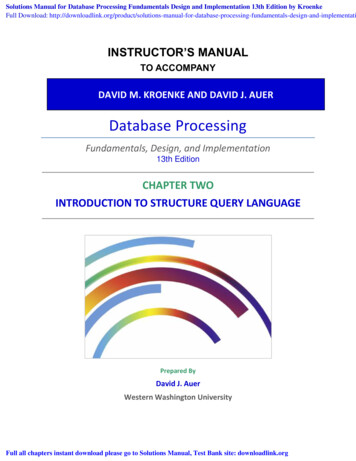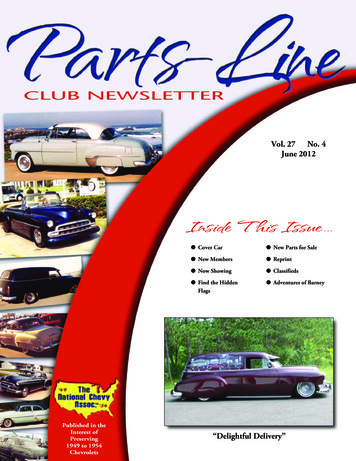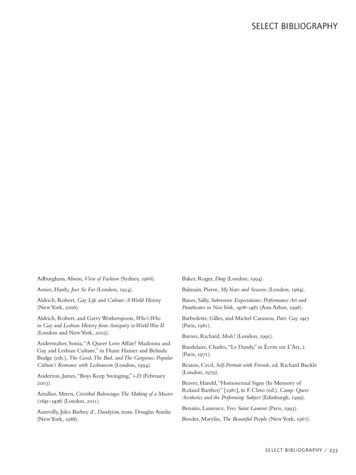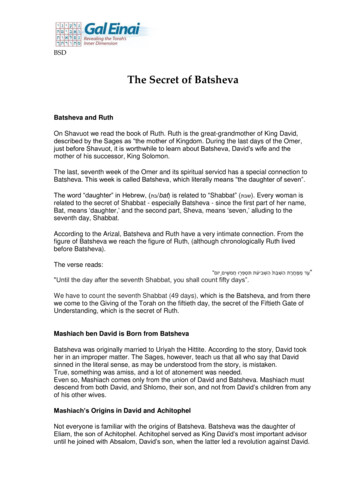
Transcription
Solutions Manual for Database Processing Fundamentals Design and Implementation 13th Edition by KroenkeFull Download: lementatiINSTRUCTOR’S MANUALTO ACCOMPANYDAVID M. KROENKE AND DAVID J. AUERDatabase ProcessingFundamentals, Design, and Implementation13th EditionCHAPTER TWOINTRODUCTION TO STRUCTURE QUERY LANGUAGEPrepared ByDavid J. AuerWestern Washington UniversityFull all chapters instant download please go to Solutions Manual, Test Bank site: downloadlink.org
Copyright 2014 Pearson Education, Inc.
Chapter Two – Introduction to Structured Query Language CHAPTER OBJECTIVES To understand the use of extracted data sets To understand the use of ad-hoc queries To understand the history and significance of Structured Query Language (SQL) To understand the basic SQL SELECT/FROM/WHERE framework as the basis fordatabase queries To be able to write queries in SQL to retrieve data from a single table To be able to write queries in SQL to use the SQL SELECT, FROM, WHERE,ORDER BY, GROUP BY, and HAVING clauses To be able to write queries in SQL to use SQL DISTINCT, AND, OR, NOT,BETWEEN, LIKE, and IN keywords To be able to use the SQL built-in functions of SUM, COUNT, MIN, MAX, and AVGwith and without the use of a GROUP BY clause To be able to write queries in SQL to retrieve data from a single table but restrictingthe data based upon data in another table (subquery) To create SQL queries that retrieve data from multiple tables using the SQL join andJOIN ON operations To create SQL queries that retrieve data from multiple tables using the SQL OUTERJOIN operationERRATAThere are no known errors at this time. Any errors that are discovered in the future willbe reported and corrected in the Online DBP e13 Errata document, which will beavailable at http://www.pearsonhighered.com/kroenke. TEACHING SUGGESTIONS Database files to illustrate the examples in the chapter and solution databasefiles for your use are available in the Instructor’s Resource Center on the text’sWeb site (www.pearsonhighered.com/kroenke). The best way for students to understand SQL is by using it. Have your studentswork through the Review Questions, Project Questions and the Marcia’s DryCleaning and Morgan Importing Project Questions in an actual database.Students can create databases in Microsoft Access with basic tables,relationships and data from the material in the book. SQL scripts for MicrosoftSQL Server, Oracle Database and MySQL versions of Cape Codd, WPC, MDCand MI are available in the Instructor’s Resource Center on the text’s Web site(www.pearsonhighered.com/kroenke).Page 2-3Copyright 2014 Pearson Education, Inc.
Chapter Two – Introduction to Structured Query Language Microsoft Access database files for Cape Codd and the NASDAQ data(NDX.accdb), together with SQL scripts for Microsoft SQL Server, OracleDatabase and MySQL versions of Cape Codd, MDC and MI are available forstudent use in the Student Resources on the text’s Web site(www.pearsonhighered.com/kroenke). The SQL processors in the various DBMSs are very fussy about character setsused for SQL statements. They want to see plain ASCII text, not fancy fonts.This is particularly true of the single quotation ( ' ) used to designate characterstrings, but I’ve also had problems with the minus sign. If your students arehaving problems getting a “properly structured SQL statement” to run, lookclosely for this type of problem. There is a useful teaching technique which will allow you to demonstrate the SQLqueries in the text using Microsoft SQL Server if you have it available. Open the Microsoft SQL Server Management Studio, and create a newSQL Server database named Cape-Codd. In the Microsoft SQL Server Management Studio, use the SQLstatements in the *.sql text file DBP-e13-MSSQL-Cape-Codd-CreateTables.sql to create the RETAIL ORDER, ORDER ITEM andSKU DATA tables [the WAREHOUSE and INVENTORY tables, used inthe Review Questions, are also created]. In the Microsoft SQL Server Management Studio, use the SQLstatements *.sql text file DBP-e13-MSSQL-Cape-Dodd-Insert-Data.sql topopulate the RETAIL ORDER, ORDER ITEM and SKU DATA tables[the WAREHOUSE and INVENTORY tables, used in the ReviewQuestions, are also populated]. In the Microsoft SQL Server Management Studio, open the *.sql text fileDBP-e13-MSSQL-Cape-Codd-Query-Set-CH02.sql. This file contains allthe queries shown in the Chapter 2 text. Highlight the query you want to run and click the Execute Query button todisplay the results of the query. An example of this is shown in thefollowing screenshot. All of the *.sql text files needed to do this are available in the Instructor’sResource Center on the text’s Web site(www.pearsonhighered.com/kroenke).Page 2-4Copyright 2014 Pearson Education, Inc.
Chapter Two – Introduction to Structured Query Language Microsoft Access 2013 does not support all SQL-92 (and newer) constructs.While this chapter still considers Microsoft Access as the DBMS most likely to beused by students at this point in the course, there are some Review Questionsand Project Questions that use the ORDER BY clause with aliased computedcolumns that will not run in Access (see Review Questions 2.42 – 2.44 andProject Questions 2.63.e – 2.63.g). The correct solutions for these questionswere obtained using Microsoft SQL Server 2012. The Microsoft Access resultswithout the ORDER BY clause are also shown, so you can assign theseproblems without the ORDER BY part of the questions. Microsoft Access 2013 does not support SQL wildcard characters (see ReviewQuestions 2.36 – 2.38), although it does have equivalent wildcard characters asdescribed in the chapter. The correct solutions for these questions wereobtained using Microsoft SQL Server 2012. For those students who are used to procedural languages, they may have someinitial difficulty with a language that does set processing like SQL. Thesestudents are accustomed to processing rows (records) rather than sets. It is timewell spent to make sure they understand that SQL processes tables at a time,not rows at a time. Students may have some trouble understanding the GROUP BY clause. If youcan explain it in terms of traditional control break logic (sort rows on a key thenprocess the rows until the value of the key changes), they will have less trouble.Page 2-5Copyright 2014 Pearson Education, Inc.
Chapter Two – Introduction to Structured Query LanguageThis also explains why the GROUP BY clause will present the rows sorted eventhough you do not use an ORDER BY clause. At this point, students familiar with Microsoft Access will wonder why they arelearning SQL. They have made queries in Microsoft Access using MicrosoftAccess's version of Query-By-Example (QBE), and therefore never had tounderstand the SQL. In many cases, they will not know that Microsoft Accessgenerates SQL code when you create a query in design view. It is worth lettingthem know this is done and even showing them the SQL created for andunderlying a Microsoft Access query. It is also important for students to understand that, in many cases, the Query-ByExample forms such as Microsoft Access’ design view can be very inefficient.Also, the QBE forms are not available from within an application program such asJava or C, and so SQL must be written. It has been our experience that a review of a Cartesian Product from an algebraclass is time well spent. Show students what will happen if a WHERE statementis left off of a join. The following example will work. Assume you create fourtables with five columns each and 100 rows each. How many columns and rowswill be displayed by the statement:SELECT * FROM TABLE1, TABLE2, TABLE3, TABLE4;The result is 20 columns (not bad) but 100,000,000 rows (100 * 100 10,000,10,000 * 100 1,000,000, 1,000,000 * 100 100,000,000). This happensbecause the JOIN is not qualified. If they understand Cartesian products thenthey will understand how to fix a JOIN where the results are much too large. Note that in the Marcia's Dry Cleaning project, where in some previous editionswe have used tables named ORDER and ORDER ITEM, we have changedthese table names to INVOICE and INVOICE ITEM. We did this becauseORDER is an SQL reserved word (part of ORDER BY). Therefore, when thetable name ORDER is used as part of a query, it may need to be ("must be" inAccess 2013) enclosed in delimiters as [ORDER] if the query is going to runcorrectly. The topic of reserved words and delimiters is discussed in more detailin Chapters 6 and 7. However, now is a good time to introduce it to yourstudents. Note that Microsoft Access SQL requires the INNER JOIN syntax instead of thestandard SQL syntax JOIN used by Microsoft SQL Server, Oracle Database andMySQLPage 2-6Copyright 2014 Pearson Education, Inc.
Chapter Two – Introduction to Structured Query Language ANSWERS TO REVIEW QUESTIONS2.1What is a business intelligence (BI) system?A business intelligence (BI) system, is a system used to support management decisions byproducing information for assessment, analysis, planning and control.2.2What is an ad-hoc query?An ad-hoc query is a query created by the user as needed, rather than a query programmed into anapplication.2.3What does SQL stand for, and what is SQL?SQL stands for Structured Query Language. SQL is the universal query language for relationalDBMS products.2.4What does SKU stand for, and what is an SKU?SKU stands for stock keeping unit. An SKU is a an identifier used to label and distinguish eachitem sold by a business.2.5Summarize how data were altered and filtered in creating the Cape Codd dataextraction.Data from the Cape Codd operational retail sales database were used to create a retail salesextraction database with three tables: RETAIL ORDER, ORDER ITEM and SKU DATA.The RETAIL ORDER table uses only a few of the columns in the operational database. Thestructure of the table is:RETAIL ORDER (OrderNumber, StoreNumber, StoreZip, OrderMonth, OrderYear,OrderTotal)For this table, the original column OrderDate (in the data format MM/DD/YYYY [04/26/2013])was converted into the columns OrderMonth (in a Character(12) format so that each month isspelled out [April]) and OrderYear (in an Integer format with each year appearing as a four-digityear [2013]).We also note that the OrderTotal column includes tax, shipping and other charges that do notappear in the data extract. Thus, it does not equal the sum of the related ExtendedPrice column inthe ORDER ITEM table discussed below.The ORDER ITEM table uses an extract of the items purchased for each order. The structure ofthe table is:ORDER ITEM (OrderNumber, SKU, Quantity, Price, ExtendedPrice)For this table, there is one row for each SKU associated with a given OrderNumber, representingone row for each type of item purchased in a specific order.Page 2-7Copyright 2014 Pearson Education, Inc.
Chapter Two – Introduction to Structured Query LanguageThe SKU DATA table uses an extract of the item identifying and describing data in the completeoperational table. The structure of the table is:SKU DATA (SKU, SKU Description, Department, Buyer)For this table, there is one row to describe each SKU, representing one particular item that is soldby Cape Codd.2.6Explain, in general terms, the relationships of the RETAIL ORDER, ORDER ITEM, andSKU DATA tables.In general, each sale in RETAIL ORDER relates to one or more rows in ORDER ITEM thatdetail the items sold in the specific order. Each row in ORDER ITEM is associated with aspecific SKU in the SKU DATA table. Thus one SKU may be associated once with eachspecific order number, but may also be associated with many different order numbers (as long asit appears only once in each order).Using the Microsoft Access Relationship window, the relationships (including the additionalrelationships with the INVENTORY and WAREHOUSE tables described after Review Question2.15) are shown in Figure 2-24 and look like this:Figure 2-23 – The Cape Codd Database with the WAREHOUSE and INVENTORY tablesIn traditional database terms (which will be discussed in Chapter 6) OrderNumber and SKU inORDER ITEM are foreign keys that provide the links to the RETAIL ORDER and SKU DATAtables respectively. Using an underline to show primary keys and italics to show foreign keys,the tables and their relationships are shown as:Page 2-8Copyright 2014 Pearson Education, Inc.
Chapter Two – Introduction to Structured Query LanguageRETAIL ORDER (OrderNumber, StoreNumber, StoreZip, OrderMonth, OrderYear,OrderTotal)ORDER ITEM (OrderNumber, SKU, Quantity, Price, ExtendedPrice)SKU DATA (SKU, SKU Description, Department, Buyer)2.7Summarize the background of SQL.SQL was developed by IBM in the late 1970s, and in 1992 it was endorsed as a national standardby the American National Standards Institute (ANSI). That version is called SQL-92. There is alater version called SQL3 that has some object-oriented concepts, but SQL3 has not receivedmuch commercial attention.2.8What is SQL-92? How does it relate to the SQL statements in this chapter?SQL-92 is the version of SQL endorsed as a national standard by the American NationalStandards Institute (ANSI) in 1992. It is the version of SQL supported by most commonly useddatabase management systems. The SQL statements in the chapter are based on SQL-92 and theSQL standards that followed and modified it.2.9What features have been added to SQL in versions subsequent to the SQL-92?Versions of SQL subsequent to SQL-92 have extended features or added new features to SQL,the most important of which, for our purposes, is support for Extensible Markup Language(XML).2.10Why is SQL described as a data sublanguage?A data sublanguage consists only of language statements for defining and processing a database.To obtain a full programming language, SQL statements must be embedded in scriptinglanguages such as VBScript or in programming languages such as Java or C#.2.11What does DML stand for? What are DML statements?DML stands for data manipulation language. DML statements are used for querying andmodifying data.2.12What does DDL stand for? What are DDL statements?DDL stands for data definition language. DDL statements are used for creating tables,relationships and other database querying and modifying data.Page 2-9Copyright 2014 Pearson Education, Inc.
Chapter Two – Introduction to Structured Query Language2.13What is the SQL SELECT/FROM/WHERE framework?The SQL SELECT/FROM/WHERE framework is the basis for queries in SQL. In thisframework:2.14 The SQL SELECT clause specifies which columns are to be listed in the query results. The SQL FROM clause specifies which tables are to be used in the query. The SQL WHERE clause specifies which rows are to be listed in the query results.Explain how Microsoft Access uses SQL.Microsoft Access uses SQL, but generally hides the SQL from the user. For example, MicrosoftAccess automatically generates SQL and sends it to the Microsoft Access’s internal AccessDatabase Engine (ADE, which is a variant of the Microsoft Jet engine) every time you run aquery, process a form or create a report. To go beyond elementary database processing, you needto know how to use SQL in Microsoft Access.2.15Explain how enterprise-class DBMS products use SQL.Enterprise-class DBMS products, which include Microsoft SQL Server, Oracle Corporation’sOracle Database and MySQL, and IBM’s DB2, require you to know and use SQL. All datamanipulation is expressed in SQL in these products.The Cape Codd Outdoor Sports sale extraction database has been modified to include twoadditional tables, the INVENTORY table and the WAREHOUSE table. The table schemas forthese tables, together with the SKU table, are as follows:RETAIL ORDER (OrderNumber, StoreNumber, StoreZip, OrderMonth, OrderYear,OrderTotal)ORDER ITEM (OrderNumber, SKU, Quantity, Price, ExtendedPrice)SKU DATA (SKU, SKU Description, Department, Buyer)WAREHOUSE (WarehouseID, WarehouseCity, WarehouseState, Manager, Squarefeet)INVENTORY (WarehouseID, SKU, SKU Description, QuantityOnHand,QuantityOnOrder)The five tables in the revised Cape Codd database schema are shown in Figure 2-24. Thecolumn characteristics for the WAREHOUSE table are shown in Figure 2-25, and the columncharacteristics for the INVENTORY table are shown in Figure 2-26. The data for theWAREHOUSE table are shown in Figure 2-27, and the data for the INVENTORY table areshown in Figure 2-28.Page 2-10Copyright 2014 Pearson Education, Inc.
Chapter Two – Introduction to Structured Query LanguageFigure 2-24 – The Cape Codd Database with the WAREHOUSE and INVENTORY tablesFigure 2-25 - Column Characteristics for the WAREHOUSE TableFigure 2-26 - Column Characteristics for the INVENTORY TablePage 2-11Copyright 2014 Pearson Education, Inc.
Chapter Two – Introduction to Structured Query LanguageFigure 2-27 - Cape Codd Outdoor Sports WAREHOUSE DataFigure 2-28 - Cape Codd Outdoor Sports INVENTORY DataPage 2-12Copyright 2014 Pearson Education, Inc.
Chapter Two – Introduction to Structured Query LanguageIf at all possible, you should run your SQL solutions to the following questions against an actualdatabase. A Microsoft Access database named Cape-Codd.accdb is available on our Web site(www.pearsonhighered.com/kroenke) that contains all the tables and data for the Cape CoddOutdoor Sports sales data extract database. Also available on our Web site are SQL scripts forcreating and populating the tables for the Cape Codd database in Microsoft SQL Server, OracleDatabase, and MySQL.NOTE: All answers below show the correct SQL statement, as well as SQL statements modifiedfor Microsoft Access 2013 when needed. Whenever possible, all results were obtained byrunning the SQL statements in Microsoft Access 2013, and the corresponding screen shots of theresults are shown below. As explained in the text, some queries cannot be run in MicrosoftAccess 2013, and for those queries the correct result was obtained using Microsoft SQL Server2012. The SQL statements shown should run with little, if any, modification needed for OracleDatabase 11g Release 2 and MySQL 5.6.Solutions to Project Questions 2.17 – 2.55 are contained in the Microsoft Access database DBPe13-IM-CH02-Cape-Codd.accdb which is available on the text’s Web site(www.pearsonhighered.com/kroenke).If your students are using a DBMS other than Microsoft Access, the SQL code to create andpopulate the Cape Codd database is available in the *.sql script files for SQL Server 2012, OracleDatabase 11g, and MySQL 5.5 in the Instructor’s Resource Center on the text’s Web site(www.pearsonhighered.com/kroenke).2.16There is an intentional flaw in the design of the INVENTORY table used in theseexercises. This flaw was purposely included in the INVENTORY tables so that you cananswer some of the following questions using only that table. Compare the SKU andINVENTORY tables, and determine what design flaw is included in INVENTORY.Specifically, why did we include it?The flaw is the inclusion of the SKU Description attribute in the INVENTORY table. Thisattribute duplicates the SKU Description attribute and data in the SKU DATA table, where theattribute rightfully belongs. By duplicating SKU Description in the INVENTORY table, we canask you to list the SKU and its associated description in a single table query against theINVENTORY table. Otherwise, a two table query would be required. If these tables were in aproduction database, we would eliminate the INVENTORY.SKU Description column.Page 2-13Copyright 2014 Pearson Education, Inc.
Chapter Two – Introduction to Structured Query LanguageUse only the INVENTORY table to answer Review Questions 2.17 through 2.39:2.17Write an SQL statement to display SKU and SKU Description.SQL Solutions to Project Questions 2.17 – 2.52 are contained in the Microsoft Access databaseDBP-e13-IM-CH02-Cape-Codd-RQ.accdb which is available on the text’s Web U, SKU DescriptionINVENTORY;Page 2-14Copyright 2014 Pearson Education, Inc.
Chapter Two – Introduction to Structured Query LanguageThe question does not ask for unique SKU and SKU Description data, but could be obtained byusing:SELECTFROMUNIQUE SKU, SKU DescriptionINVENTORY;Page 2-15Copyright 2014 Pearson Education, Inc.
Chapter Two – Introduction to Structured Query Language2.18Write an SQL statement to display SKU Description and SKU.SQL Solutions to Project Questions 2.17 – 2.52 are contained in the Microsoft Access databaseDBP-e13-IM-CH02-Cape-Codd-RQ.accdb which is available on the text’s Web U Description, SKUINVENTORY;Page 2-16Copyright 2014 Pearson Education, Inc.
Chapter Two – Introduction to Structured Query LanguageThe question does not ask for unique SKU and SKU Description data, but could be obtained byusing:SELECTFROM2.19UNIQUE SKU Description, SKUINVENTORY;Write an SQL statement to display WarehouseID.SQL Solutions to Project Questions 2.17 – 2.52 are contained in the Microsoft Access databaseDBP-e13-IM-CH02-Cape-Codd-RQ.accdb which is available on the text’s Web rehouseIDINVENTORY;Page 2-17Copyright 2014 Pearson Education, Inc.
Chapter Two – Introduction to Structured Query Language2.20Write an SQL statement to display unique WarehouseIDs.SQL Solutions to Project Questions 2.17 – 2.52 are contained in the Microsoft Access databaseDBP-e13-IM-CH02-Cape-Codd-RQ.accdb which is available on the text’s Web 21DISTINCT WarehouseIDINVENTORY;Write an SQL statement to display all of the columns without using the SQL asterisk (*)wildcard character.SQL Solutions to Project Questions 2.17 – 2.52 are contained in the Microsoft Access databaseDBP-e13-IM-CH02-Cape-Codd-RQ.accdb which is available on the text’s Web rehouseID, SKU, SKU Description,QuantityOnHand, QuantityOnOrderINVENTORY;Page 2-18Copyright 2014 Pearson Education, Inc.
Chapter Two – Introduction to Structured Query Language2.22Write an SQL statement to display all of the columns using the SQL asterisk (*) wildcardcharacter.SQL Solutions to Project Questions 2.17 – 2.52 are contained in the Microsoft Access databaseDBP-e13-IM-CH02-Cape-Codd-RQ.accdb which is available on the text’s Web NVENTORY;Page 2-19Copyright 2014 Pearson Education, Inc.
Chapter Two – Introduction to Structured Query Language2.23Write an SQL statement to display all data on products having a QuantityOnHandgreater than 0.SQL Solutions to Project Questions 2.17 – 2.52 are contained in the Microsoft Access databaseDBP-e13-IM-CH02-Cape-Codd-RQ.accdb which is available on the text’s Web ERE*INVENTORYQuantityOnHand 0;Page 2-20Copyright 2014 Pearson Education, Inc.
Chapter Two – Introduction to Structured Query Language2.24Write an SQL statement to display the SKU and SKU Description for products havingQuantityOnHand equal to 0.SQL Solutions to Project Questions 2.17 – 2.52 are contained in the Microsoft Access databaseDBP-e13-IM-CH02-Cape-Codd-RQ.accdb which is available on the text’s Web ERE2.25SKU, SKU DescriptionINVENTORYQuantityOnHand 0;Write an SQL statement to display the SKU, SKU Description, and Warehouse forproducts having QuantityOnHand equal to 0. Sort the results in ascending order byWarehouseID.SQL Solutions to Project Questions 2.17 – 2.52 are contained in the Microsoft Access databaseDBP-e13-IM-CH02-Cape-Codd-RQ.accdb which is available on the text’s Web EREORDER BYSKU, SKU Description, WarehouseIDINVENTORYQuantityOnHand 0WarehouseID;Page 2-21Copyright 2014 Pearson Education, Inc.
Chapter Two – Introduction to Structured Query Language2.26Write an SQL statement to display the SKU, SKU Description, and WarehouseID forproducts having QuantityOnHand greater than 0. Sort the results in descending order byWarehouseID and ascending order by SKU.SQL Solutions to Project Questions 2.17 – 2.52 are contained in the Microsoft Access databaseDBP-e13-IM-CH02-Cape-Codd-RQ.accdb which is available on the text’s Web EREORDER BYSKU, SKU Description, WarehouseIDINVENTORYQuantityOnHand 0WarehouseID DESC, SKU;Page 2-22Copyright 2014 Pearson Education, Inc.
Chapter Two – Introduction to Structured Query Language2.27Write an SQL statement to display SKU, SKU Description, and WarehouseID for allproducts that have a QuantityOnHand equal to 0 and a QuantityOnOrder greater than 0.Sort the results in descending order by WarehouseID and in ascending order by SKU.SQL Solutions to Project Questions 2.17 – 2.52 are contained in the Microsoft Access databaseDBP-e13-IM-CH02-Cape-Codd-RQ.accdb which is available on the text’s Web EREANDORDER BY2.28SKU, SKU Description, WarehouseIDINVENTORYQuantityOnHand 0QuantityOnOrder 0WarehouseID DESC, SKU;Write an SQL statement to display SKU, SKU Description, and WarehouseID for allproducts that have a QuantityOnHand equal to 0 or a QuantityOnOrder equal to 0. Sortthe results in descending order by WarehouseID and in ascending order by SKU.SQL Solutions to Project Questions 2.17 – 2.52 are contained in the Microsoft Access databaseDBP-e13-IM-CH02-Cape-Codd-RQ.accdb which is available on the text’s Web EREORORDER BYSKU, SKU Description, WarehouseIDINVENTORYQuantityOnHand 0QuantityOnOrder 0WarehouseID DESC, SKU;Page 2-23Copyright 2014 Pearson Education, Inc.
Chapter Two – Introduction to Structured Query Language2.29Write an SQL statement to display the SKU, SKU Description, WarehouseID, andQuantityOnHand for all products having a QuantityOnHand greater than 1 and less than10. Do not use the BETWEEN keyword.SQL Solutions to Project Questions 2.17 – 2.52 are contained in the Microsoft Access databaseDBP-e13-IM-CH02-Cape-Codd-RQ.accdb which is available on the text’s Web EREANDSKU, SKU Description, WarehouseID, QuantityOnHandINVENTORYQuantityOnHand 1QuantityOnhand 10;Page 2-24Copyright 2014 Pearson Education, Inc.
Chapter Two – Introduction to Structured Query Language2.30Write an SQL statement to display the SKU, SKU Description, WarehouseID, andQuantityOnHand for all products having a QuantityOnHand greater than 1 and less than10. Use the BETWEEN keyword.SQL Solutions to Project Questions 2.17 – 2.52 are contained in the Microsoft Access databaseDBP-e13-IM-CH02-Cape-Codd-RQ.accdb which is available on the text’s Web ERE2.31SKU, SKU Description, WarehouseID, QuantityOnHandINVENTORYQuantityOnHand BETWEEN 2 AND 9;Write an SQL statement to show a unique SKU and SKU Description for all productshaving an SKU description starting with ‘Half-dome’.SQL Solutions to Project Questions 2.17 – 2.52 are contained in the Microsoft Access databaseDBP-e13-IM-CH02-Cape-Codd-RQ.accdb which is available on the text’s Web site(www.pearsonhighered.com/kroenke).Note that, as discussed in Chapter 2, Microsoft Access 2013 uses wildcard characters that differfrom the SQL standard.For Microsoft SQL Server, Oracle Database and MySQL:SELECTFROMWHEREDISTINCT SKU, SKU DescriptionINVENTORYSKU Description LIKE 'Half-dome%';For Microsoft Access:SELECTFROMWHEREDISTINCT SKU, SKU DescriptionINVENTORYSKU Description LIKE 'Half-dome*';Page 2-25Copyright 2014 Pearson Education, Inc.
Chapter Two – Introduction to Structured Query Language2.32Write an SQL statement to show a unique SKU and SKU Description for all productshaving a description that includes the word 'Climb'.SQL Solutions to Project Questions 2.17 – 2.52 are contained in the Microsoft Access databaseDBP-e13-IM-CH02-Cape-Codd-RQ.accdb which is available on the text’s Web site(www.pearsonhighered.com/kroenke).Note that, as discussed in Chapter 2, Microsoft Access 2013 uses wildcard characters that differfrom the SQL standard.For Microsoft SQL Server, Oracle Database and MySQL:SELECTFROMWHEREDISTINCT SKU, SKU DescriptionINVENTORYSKU Description LIKE '%Climb%';For Microsoft Access:SELECTFROMWHERE2.33DISTINCT SKU, SKU DescriptionINVENTORYSKU Description LIKE '*Climb*';Write an SQL statement to show a unique SKU and SKU Description for all productshaving a ‘d’ in the third position from the left in SKU Description.SQL Solutions to Project Questions 2.17 – 2.52 are contained in the Microsoft Access databaseDBP-e13-IM-CH02-Cape-Codd-RQ.accdb which is available on the text’s Web site(www.pearsonhighered.com/kroenke).Note that, as discussed in Chapter 2, Microsoft Access 2013 uses wildcard characters that differfrom the SQL standard.For Microsoft SQL Server, Oracle Database and MySQL:SELECTFROMWHEREDISTINCT SKU, SKU DescriptionINVENTORYSKU Description LIKE ' d%';For Microsoft Access:SELECTFROMWHEREDISTINCT SKU, SKU DescriptionINVENTORYSKU Description LIKE '?d*';Page 2-26Copyright 2014 Pearson Education, Inc.
Chapter Two – Introduction to Structured Query Language2.34Write an SQL statement that uses all of the SQL built-in functions on the QuantityOnHand column. Include meaningful column names in the result.SQL Solutions to Project Questions 2.17 – 2.52 are contained in the Microsoft Access databaseDBP-e13-IM-CH02-Cape-Codd-RQ.accdb which is available on the text’s Web 35COUNT(QuantityOnHand) AS NumberOfRows,SUM(QuantityOnHand) AS TotalQuantityOnHand,AVG(QuantityOnHand) AS AverageQuantityOnHand,MAX(QuantityOnHand) AS MaximumQuantityOnHand,MIN(QuantityOnHand) AS MinimumQuantityOnHandINVENTORY;Explain the difference bet
Database Processing Fundamentals, Design, and Implementation 13th Edition CHAPTER TWO INTRODUCTION TO STRUCTURE QUERY LANGUAGE Prepared By David J. Auer Western Washington University DAVID M. KROENKE AND DAVID J. AUER Solutions Manual for Database Processing Fundamentals Design and Implementation 13th Edition by Kroenke










